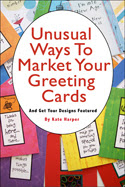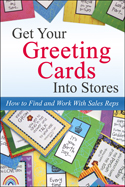
If a card publisher does not accept design submissions digitally, here are some tips for sending your designs the the U.S. mail.
A simple, inexpensive way to reach out to different
card publishers, is by compiling a a folder of your designs. Make a practice of doing research, selecting your
ideal companies, and then mailing out a packet periodically. Try to Include the following items, and remember to put your contact information on every item in the folder.
1. Any articles or ads about you and your art.
2. It's nice to show a photo of your cards in a group on a shelf. If you don't have a card rack, visit a local store and see if they will give you permission to do a quick photo of your cards on 'their' shelf. Give them your samples to keep as a thank you gift before you leave.
3. Glossy pages with photos of your card line. Include 3 or 4 of these sheets if possible. You could put a different "family" of designs, with the same look, on each sheet. (Christmas, Spring, Pastels, etc). You can also include an artist statement or short resume in this section.
4. Real card samples.
5. Glue on business card (versus sticking it in tabs). They won't fall out and it looks more attractive.
6. Instead of typing up a formal introduction, paper clip a handwritten note on card stock. People are more likely to read a quick personal note rather than a long intro letter.
7. If possible, include a CD of your card images. Label with name, contact information, business name and card line theme (floral, humor, birthday, etc). Put these in jpeg or low resolution formats, so they don't get accidentally forwarded by email and then printed by someone you don't know.


It's easy to make a sticker, or glue on a piece of paper onto the front of your folder to make it look attractive. You don't have to pay to have them printed. Print a dozen from your computer.
Use a glossy folder, and avoid flimsy thin paper folders. Also avoid folders with spine clips, unless you plan on converting your folder into a book style portfolio.
If you have a lot of design ideas, and don't want to flood your folder with too much paperwork, you can scatter cards on the table, photograph it, reduce the size and print it out on a 8 1/2 x 11 sheet of glossy photo paper.
~
Greeting Card Business ebooks.
You can support this blog by ordering Kate's
eBooks starting at only .99 cents!
They can be read on your kindle, ipad, ipod, cellphone, or your computer.
Unusual Ways to Market Your Greeting Cards and 22 Places to Get Your Designs Featured A booklet on how to get your cards noticed in non-traditional ways. Everything from why you should send cards to your dentist, to how to get special features in national publications. Great tips for designers who are starting out and want to get their cards into the hands of people beyond friends and family. Special Section: Submissions guidelines and contacts for 22 Gift Industry publications and professional gift industry blogs that seek out new greeting card designs to feature for free.
7 Mistakes Greeting Card Writers Make Booklet on common mistakes greeting card writers make and what to avoid when submitting greeting card verse to publishers. Today, greeting card publishers are shying away from traditional stereotypes, and may even include pets as family members. This article talks about how to create a trendy card that reflects the contemporary world we live in, and how to use our own personal experiences to create great card verse. Topics include: how to avoid limiting the market of who could buy your card, when to use adjectives, how not to creating card for enemies, how to write like people talk and a list of why card sentiment submissions are often rejected. The good news is you can increase your odds of success by 60% by doing a few simple things.
20 Steps to Art Licensing: How to Sell Your Designs to Card and Gift Companies A booklet on how to license your art to companies that publish greeting cards, and manufacture coffee mugs, magnets, wall hangings, kitchen items, and dozens of other gift items. This booklet covers 20 basic steps from how to prepare your art, to what companies to contact. It includes topics on: How to find agents, classes and what trade shows to attend. There are extensive resources on social media, licensing community groups, copyrights, and lists of interviews with professional designers.
Get Your Greeting Cards Into Stores: How to Find and Work With Sales Reps If you already make your own greeting cards, this book explains how to get your cards into stores and sell them sell nationwide. Included are guidelines on: how to price your cards for a profit, how to get professional feedback, where to find a sales representative and and what industry standards you should follow. All the information is also applicable to gift items, such as magnets, journals, calendars, collectibles, etc. Chapter topics: Getting Professional Feedback, Getting Your First Account, Pricing and Profits, Sales Reps 101, Where to Find Reps, Rep Readiness Checklist, Pitching Your Line to a Rep and Working With Reps.
You can also sign up for the class called
Getting into the Greeting Card Business. The content is based on my experience of working in the industry for over 20 years, and from publishing over 1,000 cards.
~











